The best ski goggles of 2022, reviewed by a ski expert

Good ski goggles can make an astounding difference to how well you can read the terrain ahead. Really sunny, bright days require a lens that filters out all of the harmful UV rays, whilst also toning things down so your eyes don’t get tired.
By contrast on cloudy, flat-light days you may need help to see the variations in the snow or where the next dip or lump is. This is where modern lens technologies have delivered huge improvements, with enhanced depth perception, clarity, and colour definition.
Photochromic lenses which automatically adjust to changing light conditions are now available from most brands, offering a real one-lens solution for the majority of your skiing. Toric lenses, with profiles that more closely match the curve of your face, are a relatively recent addition to snowsports goggles but one that is being adopted by a greater number of brands. These innovations benefit all of us.
Here's a quick look at my top five. The full reviews are further down, followed by an FAQ section where I explain the different lens shapes, colour enhancement technologies and how to choose the best goggle for you.
This year's best ski goggles, at a glance
Best overall – Smith 4D Mag S
Best women's ski goggles – Dragon NFX2
Best men's ski goggles – Oakley Flight Tracker
Best budget ski goggles – Scott Factor Pro Light Sensitive
Best snowboarding goggles – 100% Snowcraft
How to choose the right ski goggles for you
Goggles come in an array of shapes, sizes, colours and technologies. The main thing is to make sure the goggles work for your face shape. If you ski or snowboard in a helmet, try the goggles on with that, to make sure they work together.
If you wear prescription glasses when skiing, it’s essential you try the goggles on over the glasses (look out for 'OTG ready' models).
It's easy to fall into the trap of getting a goggle your friend loves. We're all unique, so a tint that works for them may not be the best solution for you. Again, trying the lenses out can let you know if your eyes like the lens colour of not. Walk around the store, look at the lights, into darker areas, look out of the window; this all helps to assess how comfortable your eyes are with that lens.
How I tested the best ski goggles

To get the best possible feel for how well the goggles work I've been to trade shows, taken goggles apart and tried to get the lenses to fall out - but most importantly I spent a lot of time skiing, wearing the goggles with a variety of ski helmets.
Best ski goggles
1. Smith 4D Mag S
Best overall, 10/10
We like: top-end tech in a smaller fit
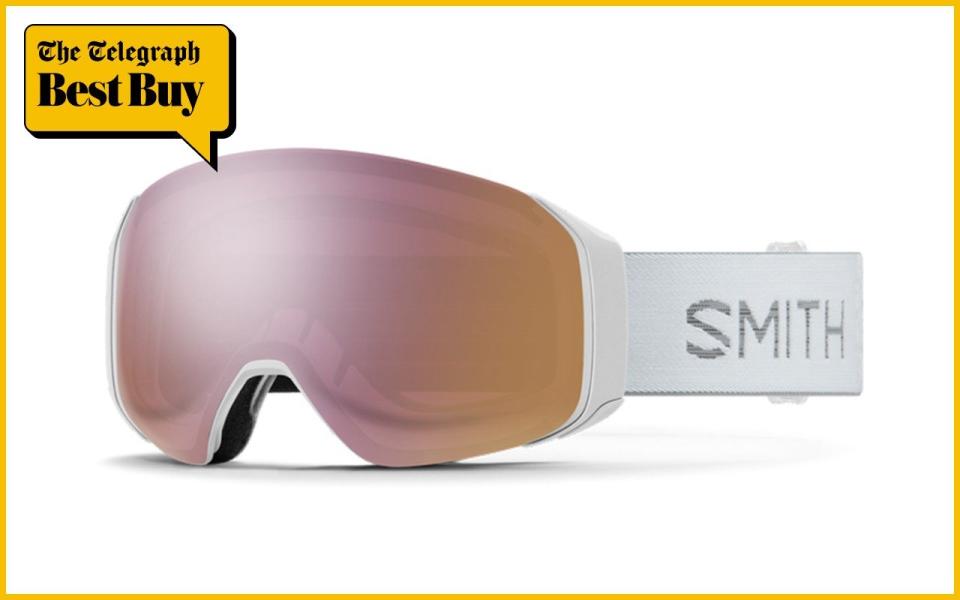
Small fit
BirdsEye spherical lens, quick change
Colour enhancement tech
Not OTG ready
There's no two-ways about it, this is an expensive goggle. It does come with two incredible lenses, a sturdy zipped protective case, microfibre bag and a GoggleSoc. Given that a spare low-light lens alone costs £113, a case is around £30 and GoggleSocs are £15, as a package it's actually cheaper than many of the one-lens competitors.
I’d heard great things from ski buddies that use Smith lenses, and found their praise justified; the definition and clarityfrom their ChromaPop technology is superb. The lens has a huge field of view, due to the pronounced curve at the bottom and into the sides. Peripheral vision is improved, but the massive benefit was felt when dealing with backpack straps and fiddling with pockets. Levers on the side of the goggle keep the lens firmly locked in, with magnets around the edge so lining the replacement lens is a cinch with gloved hands.
The beauty with the 4D Mag S is the small size (there is a larger version too). Normally, top-end tech like this comes in larger frames, but the S works really well if you have a petite nose, higher cheek bones or just a smaller framed face.
£260
Price at
Snow + Rock
2. Dragon NFX2
Best ski goggles for women, 10/10
We like: how relaxed your eyes feel

Medium fit
Cylindrical lens, quick change
Colour enhancement tech
OTG ready
Dragon does goggles with a far larger outline than this, like the PXV, which is another ace goggle, but the NFX works better for women, as well as for younger men or those with smaller faces. It has a clean outline and the Lumalens looks so good. You get a spare low light lens too.
The Swiftlock system has a lever on either side of the goggle to release the lens and this securely locks it back in place; I've never had an issue with Dragon goggles popping off when I stack it. The lens doesn’t have any fixed frame, so you do need to take a little care to avoid fingers smudges when swapping them over, but it's no biggy.
The Lumalens tech does a stellar job of enhancing colour contrast and improving depth perception. I love how relaxed my eyes feel when using it. Along with the goggle, you get a soft bag and Dragon's cool protective soft case. Pretty impressive for £155.
£120
Price at
Ellis Brigham
3. Oakley Flight Tracker L
Best men's ski goggles, 9/10
We like: superb optics and definition
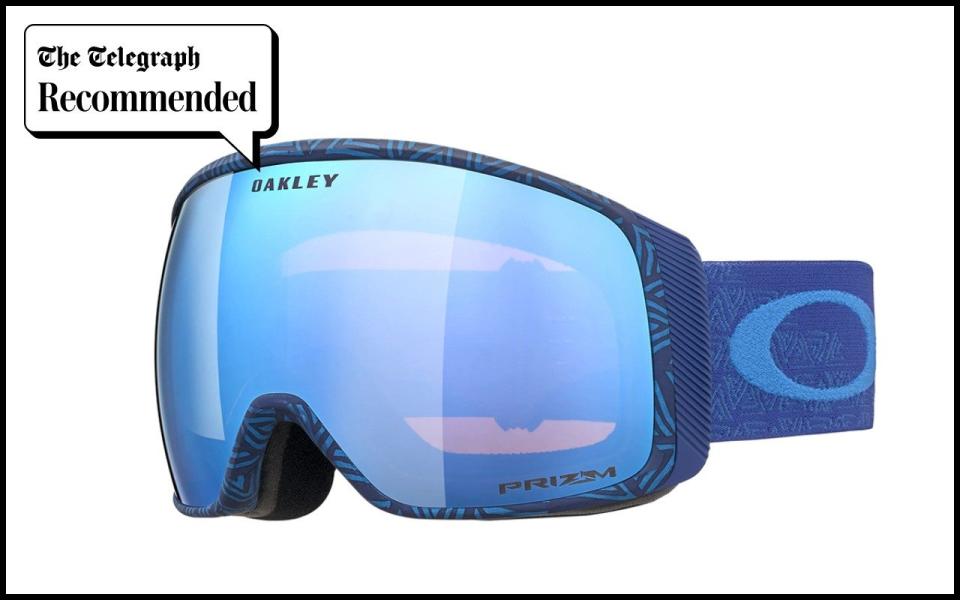
Large fit
Toric spherical lens, quick change
Colour enhancement tech
OTG (over the glasses) ready
I tested the L version of Oakley's Flight Tracker goggle but it's also available as an S model for smaller faces. The full frame design with the blue camo colourway is really striking, blending perfectly with the dark blue, silicon lined strap. (There's a massive range of colours available if blue's not your thing.)
The larger frame shape works really well for my 58cm head, sitting nicely under the variety of helmets I used without a large gap. The Prizm Sapphire Iridium lens has an amber tint and worked in a broad range of conditions. The Iridium mirror finish keeps glare at bay and Oakley's Prizm technology really helps to pick out details of what's in front of you.
The Prizm tech in the Flight Tracker is tailored specifically for snowsports, resulting in superb clarity and depth perception. The face foam is really comfy, with areas in the sides to accommodate prescription glasses. The soft, zipped case adds another level of protection when transporting your goggles. The toric lens (see my FAQ below for the difference between toric, cylindrical and spherical lenses) tapers the lens thickness, although it's hard to prove how effective it is.
All I can say is that clarity is excellent without any obvious distortion; they just work really well and look awesome.
£147
Price at
Selfridges
4. Scott Factor Pro Light Sensitive
Best budget ski goggles, 9/10
We like: value for superb quality and tech
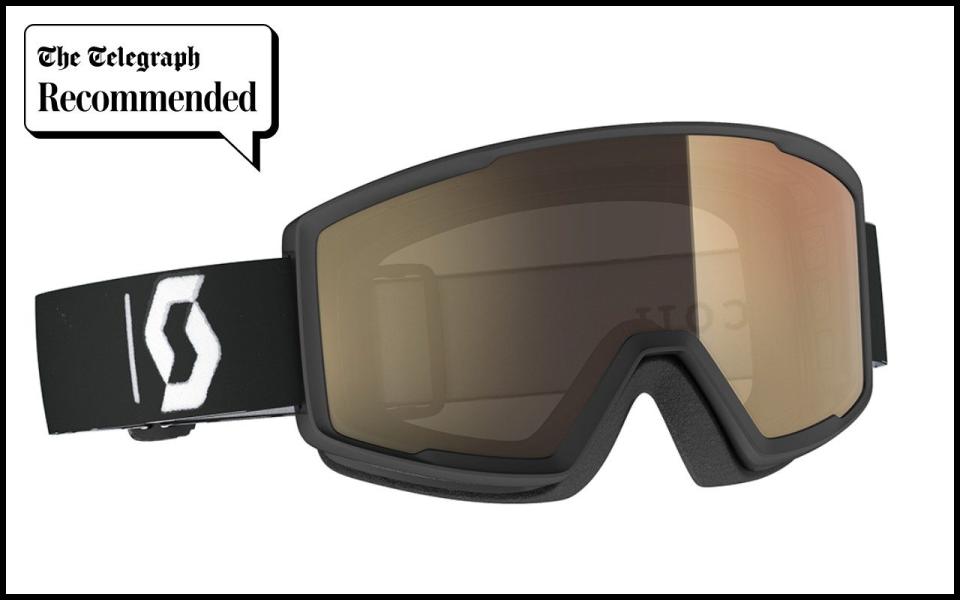
Small to medium fit
Cylindrical lens - not quick change
Colour enhancement tech
Not OTG ready
It is pretty impressive to get a goggle with a photochromic lens and such clean styling for under £100, let alone under £80. This one from Scott Sports fits a fairly broad range of face shapes and sizes, although if you want something larger then look at the Shield model (another awesome goggle, in my experience).
The Bronze Chrome lens here covers categories S1 to S3, so really does cover all the bases. They do another lens option, which looks stunning in the red mirror finish, but this only covers categories S2 to S3.
The Factor has a cylindrical shape, which is generally more economical to produce, and you get two layers of face foam rather than the three of more expensive models, but you don't notice any less comfort and it feels like a premium goggle.
There's plenty of padding to seal out the elements, the lens remained fog free and the Amplifier solution Scott has developed for handling colour really does work. The photochromic lens darkens or lightens depending on how much UV light hits the lens. These light sensitive options are excellent, as you don't need to swap out lenses as the weather changes.
£80
Price at
Scott Sports
5. 100% Snowcraft
Best goggles for snowboarding, 9/10
We like: the motocross inspired styling
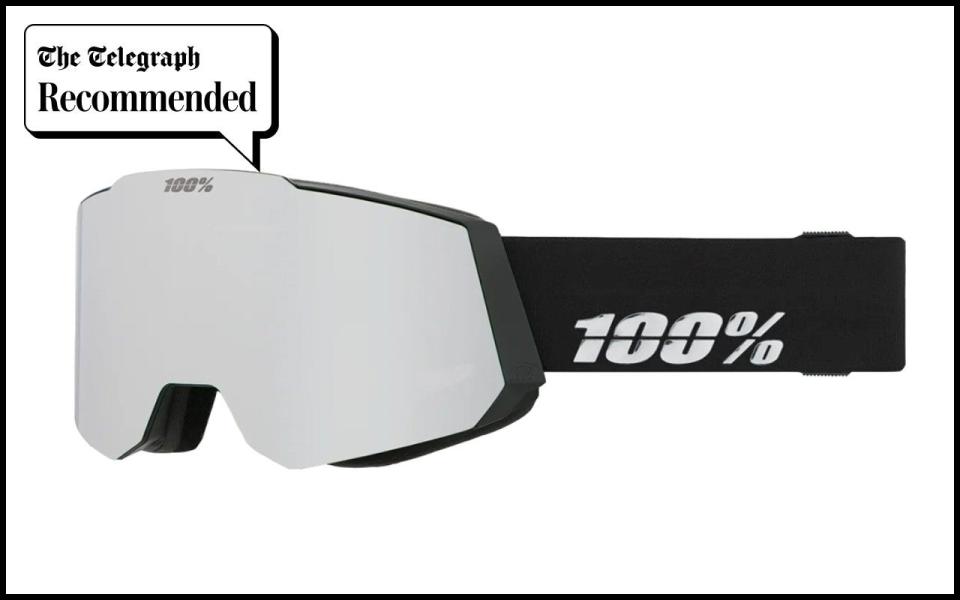
Medium to large fit
Cylindrical lens - not quick change
Colour enhancement tech
OTG ready
100% is the go-to goggle brand for motocross and downhill mountain bike racers but not so well-known in the world of skiing and snowboarding. While not everyone will want that motocross look, all those I polled when testing this thought the design looked great. I loved the angular styling.
The company's HiPer Contrasting Lens technology filters certain wavelengths of light while boosting those needed, to great effect: this goggle is very good at improving definition. The lens is also relatively thick, at 2mm, for improved impact protection.
You get a spare low light lens in the box. There's no quick-change system, so you need to pull the frame out from the lens and feed a new lens into the slots, but it's still pretty simple to do. This silver mirror lens and the spare turquoise mirror one both give a fantastic aesthetic. You can get an XL version whichi has a larger framebut uses the same lenses as the regular size Snowcraft.
£170
Price at
RX Sport
6. Atomic Four Q HD
Best double-lens goggles, 9/10
We like: the fused double lens

Medium to large fit
Cylindrical lens, quick change
Colour enhancement tech
OTG ready
The Four Q HD from Atomic is unusual in that it has two lenses fused together, instead of two separate lenses with a foam spacer between the lenses. If you pop the lens out, it feels like one thicker lens. I was sceptical about this and thought the lens would really suffer from fogging. My doubts were swiftly dealt with in some fairly harsh conditions in various locations.
It is quite impressive, on-par with a regular two-piece lens. The lens is super easy to swap out too; you squeeze the buttons on each side to release it. It has a thin frame around the edge, making it very easy to handle without causing finger marks. You can then simply pop in the spare low-light option, as the conditions dictate.
To be honest though, the HD tech of the main lens is so good I never had to swap out the lens. It is fantastic in a variety of conditions, from pretty sunny, blue-sky days through to overcast, flat light shockers. You don’t get a case, but the goggle bag does have a separate slot to protect the spare lens. It's not too big either working well for medium to larger faces.
£139
Price at
Alpinetrek
7. Bollé Torus Volt
Best vision-correcting ski goggles, 9/10
We like: the prescription insert option

Large fit
Toric spherical lens - no quick change
Colour enhancement tech
Not OTG ready
As you'd expect of a major eyewear brand, the optics here are first class. Bollé used artificial intelligence software to analyse over four million colour options to give their Volt colour enhancement the best possible clarity and depth perception. They know what they're doing with lenses and the result is superb.
The Torus Volt is designed to reduce distortion and stop fogging, and I didn't experience issues with either. It is a relatively large frame with a huge field of view. If you ski with prescription lenses, you can use Bollé's optical insert in the Torus; you’d have to get the prescription lenses made, but a lot of opticians carry Bollé eyewear anyway.
The lens rating on this ruby lens is category S2, working well in all but the brightest conditions. If you'd rather a quick release lens version, look at the Torus Neo, with magnetic lens system and a spare lens, for around £100 more.
£130
Price at
Snow + Rock
8. Shred Rarify
Best for reducing glare, 9/10
We like: the contrast boosting lens solution

Large fit
Spherical lens - not quick change
Colour enhancement tech
OTG ready
Shred is another company that's turned to high-tech computing to develop their lens solutions. Working with the MIT Sports Lab, Shred used AI to analyse millions of colour combos to see which works best in challenging skiing conditions. I was really impressed with their Contrast Boosting Lens solution and it really does help in pulling out the differences in the snowpack ahead.
They also use a semi-polarizing filter to further reduce glare. I skied it in cloudy and bright conditions, shredding into and out of shaded slopes and I could really feel the benefit. It's also a very comfortable goggle without being too big. It’s rated as a large fit, but actually I find it works on medium to large faces perfectly well. It comfortably sits over prescription glasses and the hydrophobic treatments help limit any issues with snow or moisture build-up.
If you want something for really bright conditions, then check out their CBL Hero Mirror lens, as this blocks a greater proportion of light from getting through the lens.
£100
Price at
Ski Bartlett
9. Giro Contact
Best for easy lens change, 10/10
We like: the fit, optics and neat goggle case

Medium to large fit
Toric spherical lens, quick change
Colour enhancement tech
Not OTG ready
This is another higher price-point goggle, but again you get two fantastic lenses and a case. Giro rate this as a large fit, but actually it works well on slightly smaller faces too.
The lenses are developed with Zeiss, delivering first-class optical clarity. Colour handling, contrast and definition are all boosted by Giro's Vivid solution which is dreamy in use. The toric shaping means the lens is flatter top to bottom, with a more pronounced curve around the face. You get a wide field of view, aided by the semi-frameless design to the lens.
The main lens is a category S3 tint, and the spare is category S1, so you are good to go, whatever the weather. To swap the lenses, there's a little button to up-top to release the locking mechanism. To locate the new replacement in the frame you've got an array of magnets, so even popping the lens off to cool down in hot lifts is easy.
The case is really neat with some soft protection and a spare lens sleeve; it is nice to be able to fit a firmer protective case in one pocket.
£245
Price at
Giro
10. SunGod Vulcan sunglasses
Best sunglasses for skiing, 10/10
We like: the full coverage with minimal weight
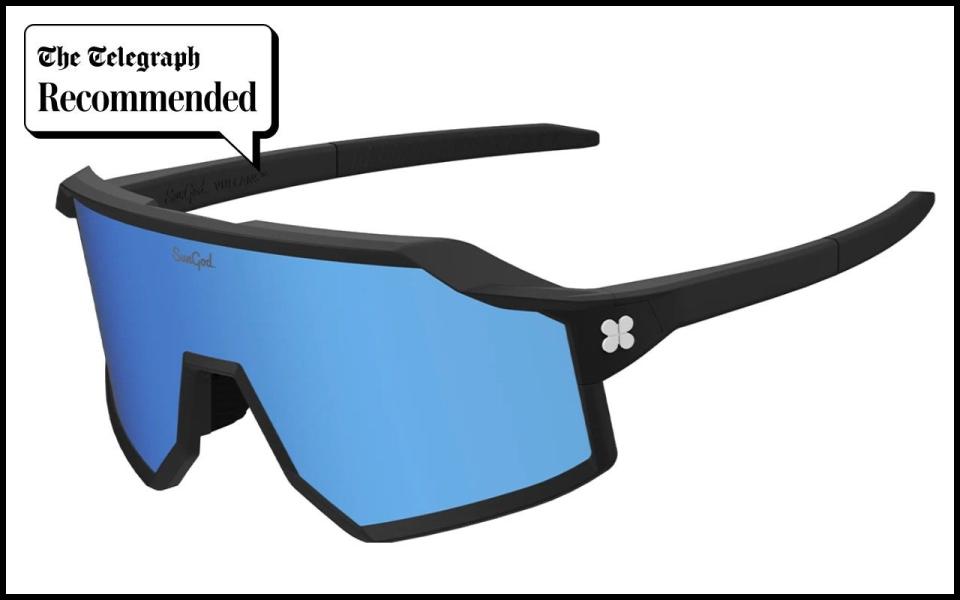
Medium to large fit
Cylindrical lens
Colour enhancement tech
SunGod make fantastic snowsports goggles but they also make killer sunglasses. The deep lens of the Vulcan provides a ton of protection and helps limit light reflecting up off the snow, into your eyes.
Not only is the Vulcan lovely to ski in, with straight legs that easily sit under or over your beanie, but they're superb when ski touring. They're available in an array of colours, many of which you can get with or without the bottom frame around the lens. You can also get it as a convertible option, so you can switch between the two.
The prices can vary, but whatever you choose you get a variety of nose pads to ensure a perfect fit. The nose and ear pads use GripLock rubber, ensuring the glasses stay firmly in place.
This colour has the excellent optics of their 8KO Silver Blue lens; a great match for those bright days in the mountains when a goggle is too hot or not dark enough. You get a lifetime guarantee, so if you break them, they'll repair them for free.
£125
Price at
SunGod
FAQ
What is the difference between a ski and snowboard goggle?
As with helmets, there is no difference between a ski and snowboard goggle. There are brands and aesthetics that are more popular with one style of sliding down a snowy slope, but function and technologies aren't unique to one or the other.
How should ski goggles fit?
Goggles come in many different shapes and fits, so make sure you try the goggles on before you buy them. You should feel the face foam contacting all around. If there's a gap, such as around the bridge of your nose, then you'll get a lot of air in and it won't work optimally or be as comfortable. You also don’t want to feel too much pressure from the frame.
If you're going to be using them with a helmet, then try them on with your helmet. If you rent a helmet, then ask the shop if you can try the goggles on with a few different helmets, to make sure you don't get that nasty gap between goggle and helmet (modern goggles integrate really well with a range of helmets, so it’s not normally a big issue).
The goggle strap should have silicon beading around the inside, which helps to keep the strap in place the helmet or over your beanie. All of the goggles featured here have this.
Is there a difference between women's and men's goggles?
Goggles are unisex. There are colours that may be preferred by some men or women, and often a larger frame works better for larger men, and smaller framed goggled can be preferred by women, but they're not just for women or men. Go for what works for your preferences and face shape.
How do I look after my goggles?
Goggles can get finger marks on the lens or damp from sweating or fresh snowfall. All of the goggles reviewed above come with a soft microfibre bag to protect them when not being worn. This bag is also used to clean the lens. If there are finger marks, you can wipe thee way easily, and sometimes breathing onto the outer lens can help. If the goggles get covered in snow. Just take care that no harsh snow crystals scratch the lens.
Lenses can also get scratched when attached to your backpack, such as when hiking, or gondolas and ski lifts. I am massive fan of GoggleSoc. This is a little protective cover, elasticated around the edge, that slips over your goggles to protect them when not on your face. It also works as a lens cleaning cloth. It then easily stores in a pocket for skiing. They also make them for visor lenses, if you prefer visors (check out my guide to the best ski helmets for visor helmets).
If your lenses get iced up on the outside, let this melt before trying to clear the lens. If you get snow inside the goggle, it can be very tempting to wipe this away. Don’t do this. Moisture can soften the excellent anti-fog coating on the inner lens, and you can damage this if you wipe it when wet. Instead, tap the goggle against your leg or hand to clear the snow out. Then let it air dry as much as possible, such as while having lunch. This can also be why it's handy having more than one lens, so you can swap one out if it gets wet.
Air dry your goggle each night between ski days. Avoid putting them on a radiator or directly next to a heat source. Always allow your goggles to air once you get back home from your trip, and store them in their microfibre bag. Some goggles come with a protective case. This is superb for transporting and storing your goggles, once they're dried.
What colour lens is best for skiing?
Goggle lenses come in a vast array of colours and tints. Darker tints are better for brighter conditions as they let less light through the lens (they have a lower 'VLT' - see next FAQ point). A lighter tint, or even a clear lens lets more light through and is better when it's really cloudy, snowing or when night skiing.
The actual colour of the lens ranges from really dark greys and browns, through amber, rose, blue, yellow and clear. There's a massive range even within these, so again this is why trying the goggles on is super important. Some people really like an amber lens, others prefer a yellow colour when it's cloudy, while for many this just isn't comfortable and a rose may work better.
This is why trying the goggles on in a shop absolutely makes a difference. Walk around the shop to where the lights are bright, where there's more shadow and look out of the windows. You can quickly tell if your eyes are relaxed in a certain lens. If the goggle comes with more than one lens, try them both on to make sure your eyes are happy.
Modern lenses now often have superb colour handling. Each brand can have a different way to solve this problem, but the result is excellent depth perception, boosted contrast and an easier time in differentiating between changes in snow.
Essentially, brands are looking to filter out wavelengths of light that don't help and enhance wavelengths that do. Brands have their own name for their solution, such as Oakley's Prizm, Bollé's Volt, Scott's Amplifier, Smith's ChromaPop and so on.
What is VLT in ski goggles?
VLT stands for Visual Light Transmission and lets you know how much light can get through the lens, given as a percentage. The lower the VLT, the less light permitted through and the darker the lens will seem. A higher VLT lets more light through and works great when you have those dreaded flat-light days. I've not stated the VLT for each goggle, as it will change depending on the lens you go for.
VLT is not a rating of stopping harmful UV light though. All of the goggles here protect against damaging UV light. Check the goggle packaging to ensure it states 100% UV protection, sometimes rated as UV 400.
Lenses, as with sunglasses, are split into five categories from 0 to 4. Lenses for snowsports have an S before the number, so a category S1 lens is designed for use in snowy terrain and lets quite a lot of light through. Category S4 is the darkest option for really bright, sunny days. The majority of snowsports goggles have a category S2 or S3 lens, working for typical winter conditions you get in the mountains.
You can also get photochromic, or photochromatic, lenses. These lenses automatically change how light or dark they are, depending on how much UV light hits the lens. Some cover only a couple of categories, such as S2-S3, while others have a greater range, covering 3 categories. Photochromic lenses don’t change tint instantly but over a minute or so.
It's also important to note that the majority of photochromic lenses won't go to their lightest tints when it's really cold; it's just a limitation of how they work. This is why some photo lens goggles come with a spare low-light lens.
If you ski in sunny conditions then you may be looking at polarized lenses. You don't get many polarized goggles as it can make picking out the difference between soft and hard snow, or ice, more challenging. Some brands use a semi-polarized filter to help deal with this problem.
Do goggles work with prescription glasses?
If you’re a glasses wearer, look for goggles that are over-the-glasses ready. These will state OTG on their info. I've included this in the info for each of the goggles above, to help you.
OTG goggles typically have a notch in the frame design which permits the face foam to squash out of the way of the legs of the glasses, without letting a load of cold air in. It is best to try to the goggles on over your glasses to make sure they work together. You may well find your glasses will be 'held' by the goggle when you take the goggle off; this is totally normal.
What is the difference between a cylindrical, spherical or toric lens shape?
Goggle lenses come in various shapes. The classic design where it's flat vertically but curved around your face, side to side, is called cylindrical (like it's been formed around a cylinder). This is an old-school way of shaping lenses but very contemporary in look. Modern lens construction techniques mean these lenses now offer far less distortion than their ancestors.
Spherical lenses have a curve in both directions, up and down and side to side, like the lens has been cut from a sphere. This is closer to the shape of your eyeball, so can offer excellent vision. The lens also sits further way from your face, so some find you get reduced fogging with a spherical lens.
Toric lenses are a relatively new development in snowsports goggles. There a few ways to make toric lenses. Some brands tailor the thickness of the lens in different areas, while others focus on the curvature of the lens, and there may a blend of both techniques.
The easiest way to picture a toric lens can be to imagine a donut balanced on its thin side, with the hole in the middle. Imagine taking a small goggle lens section out of the edge closest to you; this will have a pronounced curve side to side in the lens, but the vertical curve will be much flatter. Toric lenses can provide an incredible field of view and the best distortion-free optics.

 Yahoo Movies
Yahoo Movies 
